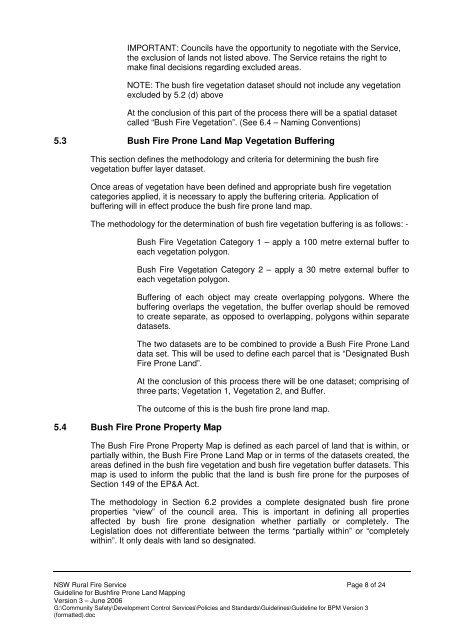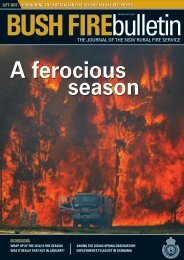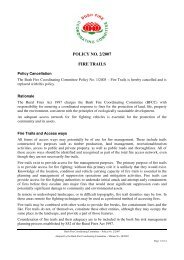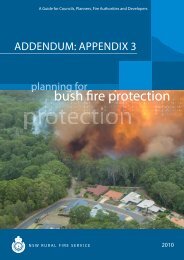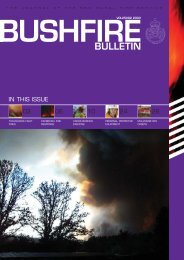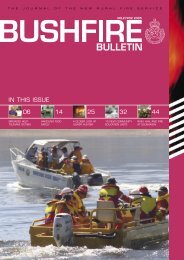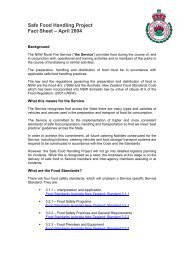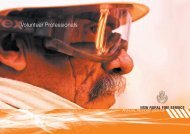GUIDELINE - NSW Rural Fire Service
GUIDELINE - NSW Rural Fire Service
GUIDELINE - NSW Rural Fire Service
You also want an ePaper? Increase the reach of your titles
YUMPU automatically turns print PDFs into web optimized ePapers that Google loves.
IMPORTANT: Councils have the opportunity to negotiate with the <strong>Service</strong>,<br />
the exclusion of lands not listed above. The <strong>Service</strong> retains the right to<br />
make final decisions regarding excluded areas.<br />
NOTE: The bush fire vegetation dataset should not include any vegetation<br />
excluded by 5.2 (d) above<br />
At the conclusion of this part of the process there will be a spatial dataset<br />
called “Bush <strong>Fire</strong> Vegetation”. (See 6.4 – Naming Conventions)<br />
5.3 Bush <strong>Fire</strong> Prone Land Map Vegetation Buffering<br />
This section defines the methodology and criteria for determining the bush fire<br />
vegetation buffer layer dataset.<br />
Once areas of vegetation have been defined and appropriate bush fire vegetation<br />
categories applied, it is necessary to apply the buffering criteria. Application of<br />
buffering will in effect produce the bush fire prone land map.<br />
The methodology for the determination of bush fire vegetation buffering is as follows: -<br />
Bush <strong>Fire</strong> Vegetation Category 1 – apply a 100 metre external buffer to<br />
each vegetation polygon.<br />
Bush <strong>Fire</strong> Vegetation Category 2 – apply a 30 metre external buffer to<br />
each vegetation polygon.<br />
Buffering of each object may create overlapping polygons. Where the<br />
buffering overlaps the vegetation, the buffer overlap should be removed<br />
to create separate, as opposed to overlapping, polygons within separate<br />
datasets.<br />
The two datasets are to be combined to provide a Bush <strong>Fire</strong> Prone Land<br />
data set. This will be used to define each parcel that is “Designated Bush<br />
<strong>Fire</strong> Prone Land”.<br />
At the conclusion of this process there will be one dataset; comprising of<br />
three parts; Vegetation 1, Vegetation 2, and Buffer.<br />
The outcome of this is the bush fire prone land map.<br />
5.4 Bush <strong>Fire</strong> Prone Property Map<br />
The Bush <strong>Fire</strong> Prone Property Map is defined as each parcel of land that is within, or<br />
partially within, the Bush <strong>Fire</strong> Prone Land Map or in terms of the datasets created, the<br />
areas defined in the bush fire vegetation and bush fire vegetation buffer datasets. This<br />
map is used to inform the public that the land is bush fire prone for the purposes of<br />
Section 149 of the EP&A Act.<br />
The methodology in Section 6.2 provides a complete designated bush fire prone<br />
properties “view” of the council area. This is important in defining all properties<br />
affected by bush fire prone designation whether partially or completely. The<br />
Legislation does not differentiate between the terms “partially within” or “completely<br />
within”. It only deals with land so designated.<br />
<strong>NSW</strong> <strong>Rural</strong> <strong>Fire</strong> <strong>Service</strong> Page 8 of 24<br />
Guideline for Bushfire Prone Land Mapping<br />
Version 3 – June 2006<br />
G:\Community Safety\Development Control <strong>Service</strong>s\Policies and Standards\Guidelines\Guideline for BPM Version 3<br />
(formatted).doc


